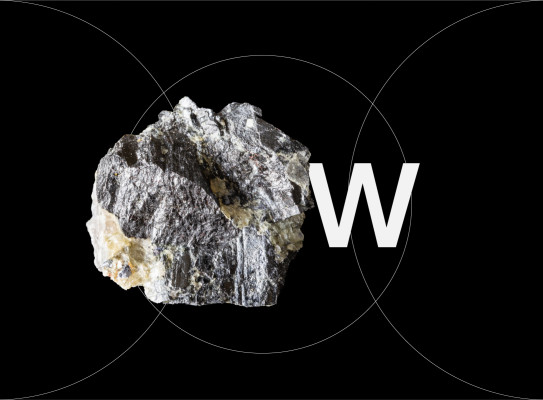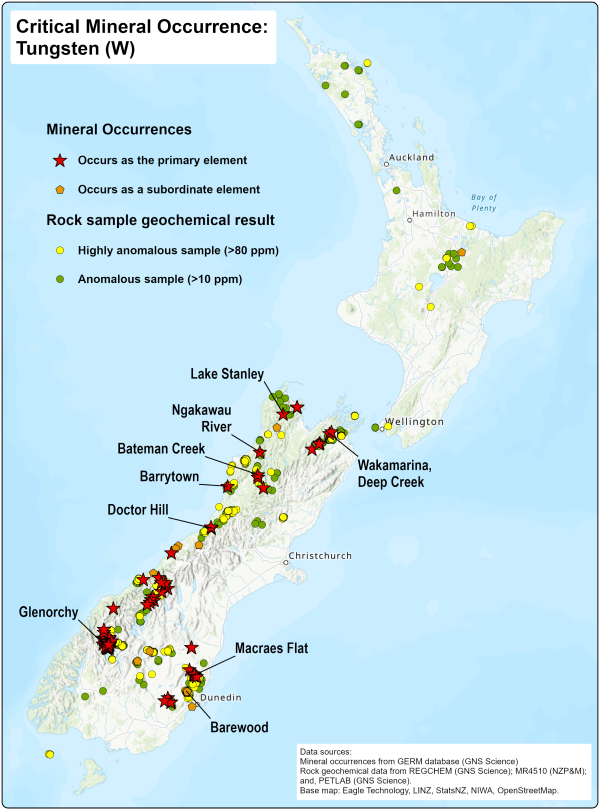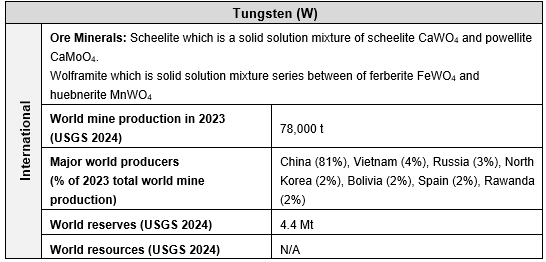Tungsten

Tungsten (W) is one of the most important and versatile critical elements, known for its exceptional hardness, high melting point (3,422°C), and strength. These properties make it essential for a range of industrial, technological, and military applications.
Tungsten in New Zealand
Orogenic schist-hosted quartz-scheelite ± gold lodes in Otago and Marlborough form the most abundant type of tungsten deposit in New Zealand. Glenorchy, Macraes and Wakamarina are the largest of these. Scheelite also occurs in quartz veins associated with granite in Northwest Nelson, Buller and Westland. Wolframite accompanies cassiterite in greisen on the Tin Range in southern Rakiura / Stewart Island.
New Zealand hosts a variety of tungsten (W) deposits, primarily in the form of scheelite (CaWO₄)-bearing quartz veins, with some occurrences in greisen, skarn, and stratabound deposits. Historically, tungsten mining in New Zealand focused on gold-associated scheelite veins, with production mainly from Otago, Marlborough, and Westland.

-
Orogenic Scheelite-Bearing Quartz Veins
These quartz lodes occur in the Marlborough, Alpine, and Otago schists, often along shear zones cutting across the regional foliation. Key historical mining areas include:
- Wakamarina (Marlborough) – 475 t of concentrate (65% WO₃) produced (1874–1944).
- Glenorchy (Otago) – Largest tungsten producer in NZ, yielding 2,188 t of scheelite concentrate (1881–1965).
- Macraes Flat (Otago) – Produced ~1,000 t of scheelite concentrate (1875–1936).
- Barewood (Otago) – Gold-scheelite association in quartz veins.
Total recorded tungsten production in New Zealand is 3,828 t of tungsten concentrate.
-
Greisen W-Sn Deposits
- Hydrothermal greisen-hosted tungsten-tin mineralisation is found along the Karamea Batholith in Nelson and Westland (e.g., Bateman Creek, Barrytown, Doctor Hill).
- Scheelite is dominant over wolframite and cassiterite, differing from classic Sn-W granite provinces.
- The Tin Range (Rakiura/Stewart Island) is a more typical greisen deposit, containing cassiterite and wolframite but no scheelite.
-
Stratabound W Deposits
- Lake Stanley (Northwest Nelson) – Scheelite occurs in marble-hosted streaks and lenses, likely formed by synsedimentary-exhalative processes.
- Southern Alps (Lake Hawea to Mt Cook) – Extensive zone (60 km long, 8 km wide) with scheelite in quartz veins, disseminations, and bedding-bound layers within greenschist facies schists.
- Dansey Pass (North Otago) – Scheelite mineralisation in Permian metavolcanics, with vein grades up to 1.3% WO₃.
Exploration Potential
- Gold-associated scheelite remains the most significant deposit type in New Zealand.
- Greisen and skarn-hosted scheelite in Northwest Nelson could be further explored.
- Southern Alps and Dansey Pass show potential for stratabound scheelite deposits, but economic viability is uncertain.
New Zealand’s tungsten resources, while historically significant, remain largely underexplored with modern techniques.
Why Tungsten is a Critical Element
- Supply Risk – China controls over 80% of global tungsten production, making other countries dependent on imports.
- Economic and Strategic Importance – Essential for industrial applications, defence, and emerging technologies.
- Limited Substitutes – No other element matches tungsten’s unique combination of hardness, density, and heat resistance.
As demand for high-performance materials grows, tungsten remains an irreplaceable element for modern industry, defence, and technological advancements.
Key Uses of Tungsten
Industrial and Manufacturing Applications
- Hard Metals and Cutting Tools – Tungsten carbide (WC) is used in drill bits, cutting tools, and mining equipment due to its extreme hardness and wear resistance.
- Steel Alloys – Added to steel to improve strength, toughness, and resistance to heat and corrosion (e.g., in aerospace and automotive industries).
Electronics and High-Temperature Applications
- Filaments and Electrical Contacts – Tungsten is used in incandescent light bulbs, electrodes, and X-ray tubes due to its ability to withstand extreme heat.
- Semiconductors and Microelectronics – Used in thin-film transistors, integrated circuits, and high-performance electronic components.
Military and Aerospace Applications
- Armour-Piercing Ammunition – Tungsten’s high density makes it a key component in military-grade projectiles and radiation shielding.
- Rocket Nozzles and Aerospace Components – Withstands high temperatures in space exploration and jet engine parts.
Medical and Scientific Uses
- Radiation Shielding – Used in medical imaging and cancer treatment devices.
- Biomedical Applications – Found in surgical instruments and implants.
Geological Occurrence
Tungsten is primarily found in hydrothermal vein deposits, skarn deposits, and granite-related ore bodies. It occurs in minerals such as:
- Scheelite (CaWO₄) – Typically found in skarns and hydrothermal veins.
- Wolframite ((Fe,Mn)WO₄) – Commonly associated with quartz veins in granite intrusions.
Global Supply
The world’s largest tungsten producers include China, Russia, and Vietnam, with China dominating the market.

Additional Reading
Bentley 1995; Tulloch and Mackenzie 1986; Brathwaite and Pirajno 1993; Durance and Polette 2016) Maxwell 1983; Brathwaite and Pirajno 1993
Christie AB, Brathwaite RL. 1996b. Mineral commodity report 12: tungsten. New Zealand Mining. 19:19–27.
Durance PMJ, Polette D. 2016. A Review of the Kirwan Hill tungsten and gold prospect, West Coast. In: Christie AB, editor. Mineral deposits of New Zealand: exploration and research. Carlton (AU): Australasian Institute of Mining and Metallurgy. Monograph series; 31 p. 471–479.
Pirajno F, Bentley PN. 1985. Greisen-related scheelite, gold and sulfide mineralisation at Kirwins Hill and Bateman Creek, Reefton district, Westland, New Zealand. New Zealand Journal of Geology and Geophysics. 28:97–109. https://doi.org/10.1080/00288306.1985.10422279(external link)